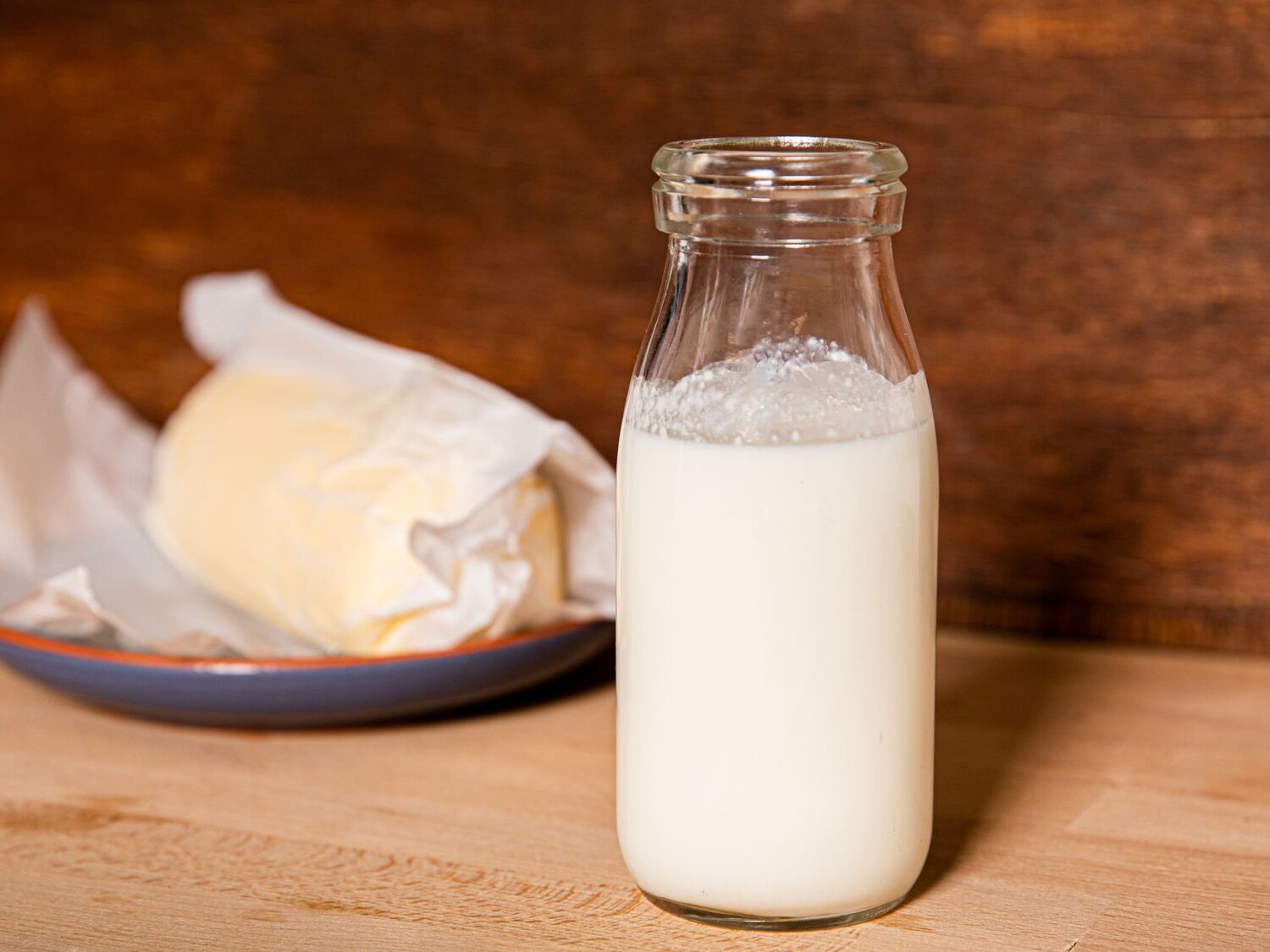Creating buttermilk at home is a simple and quick process that can enhance the flavor and texture of your baked goods. This homemade version is a great substitute when you don't have store-bought buttermilk on hand.
The ingredients for this recipe are quite common and likely already in your kitchen. However, if you don't have lemon juice or white vinegar, you will need to pick one up from the supermarket. These acidic components are essential for curdling the milk and creating the buttermilk effect.

Ingredients For Buttermilk Recipe
Milk: The base of the recipe, preferably whole milk for a richer texture.
Lemon juice: An acidic component that curdles the milk, creating the buttermilk consistency.
White vinegar: An alternative to lemon juice, also used to curdle the milk.
Technique Tip for Making Buttermilk
To ensure your buttermilk has the right consistency and tang, use whole milk for a richer flavor. If you don't have lemon juice or white vinegar, you can also use apple cider vinegar as a substitute. Make sure to let the mixture sit for the full 10 minutes to allow it to thicken properly. This resting time is crucial for the acid to react with the milk, creating the desired texture and taste.
Suggested Side Dishes
Alternative Ingredients
whole milk - Substitute with 2% milk: If you don't have whole milk, 2% milk can be used as it still provides a good amount of fat content, which is essential for the texture of buttermilk.
whole milk - Substitute with skim milk: Skim milk can be used in a pinch, but the resulting buttermilk will be less rich and creamy due to the lower fat content.
whole milk - Substitute with plant-based milk: For a dairy-free option, use almond milk, soy milk, or oat milk. These alternatives can mimic the consistency of whole milk when mixed with an acid.
lemon juice - Substitute with white vinegar: Both acids will curdle the milk to create buttermilk. The choice between them can depend on what you have on hand or your flavor preference.
lemon juice - Substitute with apple cider vinegar: Apple cider vinegar can also be used as it has a similar acidity level to lemon juice and will achieve the same curdling effect.
lemon juice - Substitute with cream of tartar: Use 1 ¾ teaspoons of cream of tartar mixed with 1 cup of milk to create buttermilk. This is another acidic ingredient that can curdle the milk effectively.
Other Alternative Recipes Similar to This
How to Store or Freeze Buttermilk
To store your freshly made buttermilk, pour it into a clean, airtight container. Glass jars or plastic containers with tight-fitting lids work best.
Label the container with the date you made the buttermilk. This helps you keep track of its freshness.
Place the container in the coldest part of your refrigerator, typically the back of the bottom shelf. Buttermilk can be stored in the fridge for up to two weeks.
If you notice any separation, simply give the container a good shake before using the buttermilk in your recipes.
For freezing, pour the buttermilk into ice cube trays. This allows you to use small portions as needed without thawing the entire batch.
Once frozen, transfer the buttermilk cubes to a resealable plastic freezer bag or an airtight container. Label the bag or container with the date.
Store the frozen buttermilk cubes in the freezer for up to three months. This method is perfect for adding a splash of buttermilk to soups, sauces, or baked goods.
When ready to use, thaw the desired amount of buttermilk cubes in the refrigerator overnight or at room temperature for a quicker option. Stir well before incorporating into your recipes.
Avoid refreezing buttermilk once it has been thawed, as this can affect its texture and flavor.
If you find yourself with an abundance of buttermilk, consider using it in a variety of recipes such as pancakes, waffles, biscuits, or even as a tenderizing marinade for meat.
How to Reheat Leftovers
- Pour the milk into a measuring cup.
- Add the lemon juice or vinegar to the milk.
- Stir well and let it sit for 5-10 minutes.
- Use as needed in your recipe.
Best Tools for Making Buttermilk
Measuring cup: Use this to accurately measure 1 cup of milk.
Tablespoon: This will help you measure out 1 tablespoon of lemon juice or vinegar.
Spoon: Use a spoon to stir the milk and acid together thoroughly.
Timer: Set this to ensure you let the mixture sit for the required 5-10 minutes.
Container: A small bowl or cup to hold the buttermilk while it sits.
How to Save Time on Making Buttermilk
Prepare ingredients in advance: Measure out milk and lemon juice or vinegar ahead of time to streamline the process.
Use a timer: Set a timer for the 5-10 minute waiting period to ensure you don't forget and can multitask efficiently.
Make in bulk: Prepare a larger batch of buttermilk and store it in the fridge for future recipes.
Use a whisk: Stir the mixture with a whisk to combine the ingredients more quickly and thoroughly.
Room temperature milk: Use milk at room temperature to speed up the curdling process.

Buttermilk Recipe
Ingredients
Main Ingredients
- 1 cup Milk Preferably whole milk
- 1 tablespoon Lemon juice or white vinegar
Instructions
- 1. Pour the milk into a measuring cup.
- 2. Add the lemon juice or vinegar to the milk.
- 3. Stir well and let it sit for 5-10 minutes.
- 4. Use as needed in your recipe.
Nutritional Value
Keywords
More Amazing Recipes to Try 🙂
- Low Country Boil Recipe1 Hours
- Gluten-Free Vegan Banana Bread Muffins Recipe40 Minutes
- Carrot Pineapple Cake Recipe1 Hours
- Strawberry Salad Recipe15 Minutes
- Greekhouse Dressing Recipe10 Minutes
- Keto and Vegan Chocolate Almond Balls Recipe10 Minutes
- Gluten-Free Mascarpone Pound Cake Recipe1 Hours 15 Minutes
- Parmesan Garlic Keto Chicken Wings Recipe40 Minutes

Leave a Reply